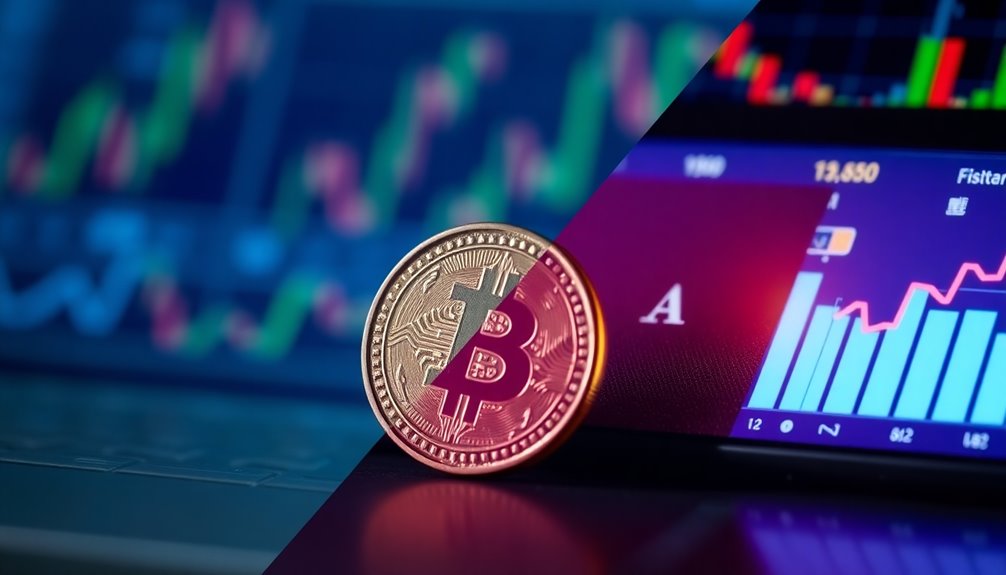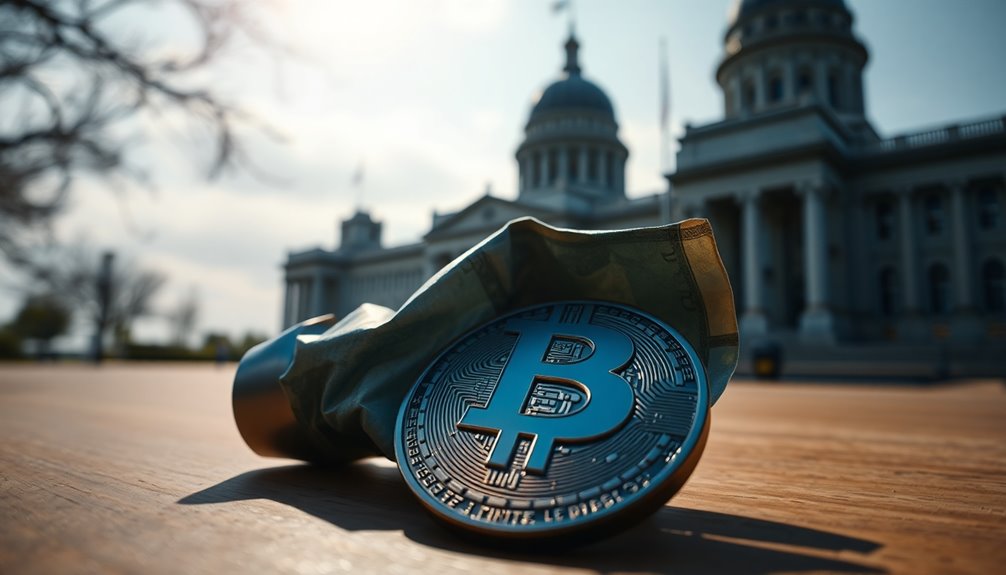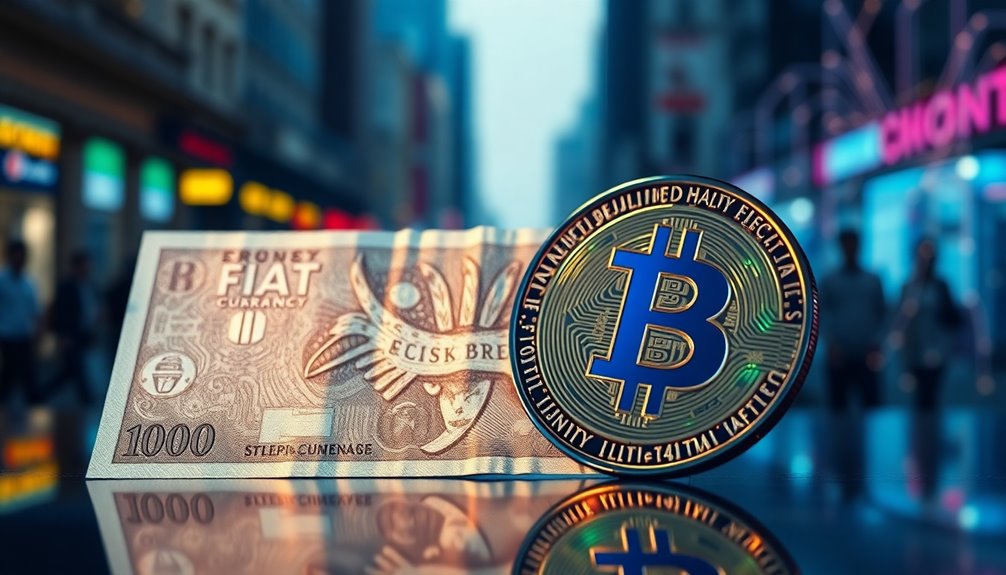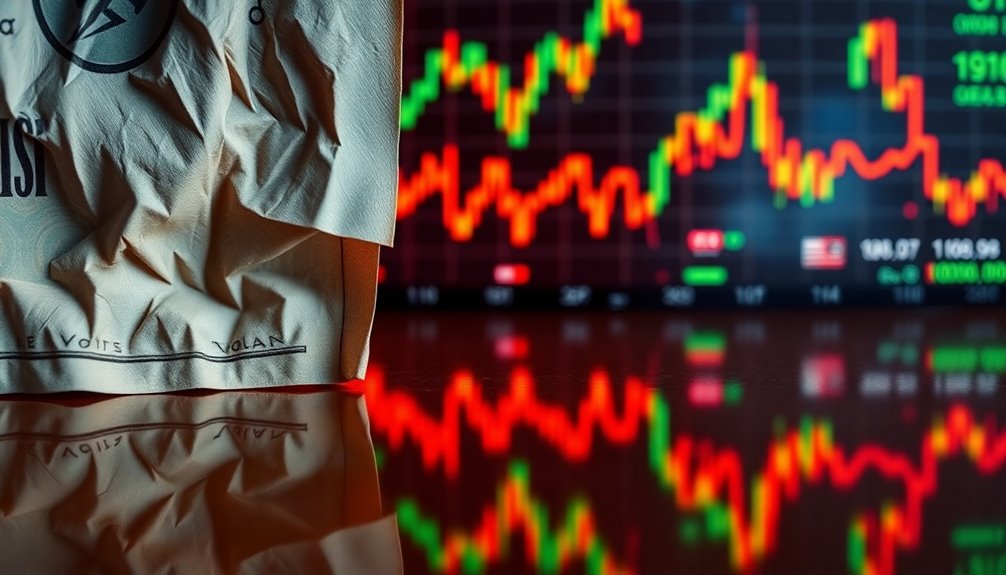Fiat currency plays a pivotal role in cryptocurrency by providing a stable reference point within the fluctuating financial landscape. Its value stems from government backing and user trust, making it essential for understanding digital assets. While fiat currency offers stability and is governed by monetary policy, cryptocurrencies present innovative alternatives that challenge traditional systems. The relationship between them highlights both opportunities and risks. As more retailers adopt cryptocurrencies, the dynamic between fiat and digital currencies becomes even more interesting. You might find it enlightening to explore how this evolving landscape impacts your financial decisions.
Key Takeaways
- Fiat currency provides a stable foundation for measuring the value of cryptocurrencies in financial markets.
- Government backing of fiat currencies influences the perception and adoption of cryptocurrencies among users.
- The transition from fiat to cryptocurrencies can enhance financial inclusivity by offering alternatives to traditional banking systems.
- Central banks may adopt cryptocurrencies or stablecoins to leverage the benefits of digital currencies while maintaining monetary control.
- Regulatory frameworks for cryptocurrencies often reference fiat currencies to establish guidelines and ensure user protection.
Fiat's Intrinsic Value Explained

Fiat currency operates on the principle of trust, relying on government backing and user confidence rather than physical assets. Its intrinsic value stems from the stability of the issuing government, which reflects economic health and the ability to repay debts.
Central banks play a crucial role in this system by regulating the supply of fiat money through monetary policy, impacting inflation and purchasing power. Unlike cryptocurrency, which derives its value from market demand and technology, fiat is established as legal tender by government decree.
However, fluctuations can occur, as seen with the Zimbabwean dollar's drastic devaluation. Ultimately, the value of fiat currency hinges on user trust, making it essential to understand its underlying principles in the broader financial landscape.
Fiat's Historical Significance in Finance

As the world shifted away from the gold standard in the 20th century, the significance of fiat currency in finance became increasingly apparent.
Fiat currency, especially the US dollar, emerged as a vital tool for central authorities to implement monetary policy and manage economic stability. This flexibility allowed governments to respond to inflationary pressures and maintain a store of value, albeit not without challenges.
Instances of price volatility, like the hyperinflation in Zimbabwe, exposed the vulnerabilities in fiat systems, sparking interest in alternative currencies such as cryptocurrency.
As cryptocurrencies gain traction, they raise questions about their potential coexistence with fiat currencies, reshaping our understanding of finance and the future of money.
Fiat's Backing by Governments

The strength of fiat currency lies in its backing by government authorities, which creates a legal framework that instills trust among users.
Fiat currencies, issued by a government, derive their value from the stability and economic strength of that authority. Central banks, like the Federal Reserve, utilize monetary policy tools such as interest rate adjustments to manage the supply and value of fiat.
Trust in a fiat currency's value is influenced by inflation rates and government debt levels, which can fluctuate.
As the primary medium of exchange, fiat currencies establish a foundation for cryptocurrency markets, allowing you to compare and convert value between fiat and digital assets effectively.
This relationship underscores the importance of strong governmental backing in maintaining economic stability.
Pros and Cons Summary

While both fiat currency and cryptocurrency offer unique advantages, they also come with distinct drawbacks that users should consider.
Fiat currency provides stability, serving as a reliable reference point in a volatile financial system. However, it may lack the innovation seen in digital assets.
Cryptocurrencies, particularly stablecoins, mitigate market fluctuations but can be subject to regulatory challenges that impact their adoption. The evolving regulatory environment can either enhance consumer protection or stifle growth.
Additionally, while cryptocurrencies promote financial inclusivity by offering access to those without traditional banking, reliance on fiat for transactions can limit this potential.
Balancing these pros and cons is essential for making informed decisions in the ever-changing landscape of digital finance.
Fiat vs. Crypto Transaction Speed

When you compare fiat and cryptocurrency transaction speeds, you'll notice a significant difference in efficiency. Fiat transactions often involve intermediaries like banks, leading to slower processing times and higher fees, especially for cross-border payments.
In contrast, cryptocurrency transactions occur directly on blockchain technology, allowing for quick processing that can be completed in minutes, regardless of location. For example, while a traditional bank transfer might take days, a Bitcoin transaction is confirmed in about 10 minutes, and faster networks like Hedera can finalize transactions in mere seconds.
Additionally, cryptocurrency typically incurs lower fees, making it ideal for micropayments and international transfers. Stablecoins, pegged to fiat currencies, further enhance transaction speed in e-commerce while maintaining value stability.
Volatility in Cryptocurrency Markets

Though many investors are drawn to the potential for high returns, the volatility in cryptocurrency markets can be daunting.
Cryptocurrencies can fluctuate by over 10% in a single day, starkly contrasting fiat money's value. For example, Bitcoin soared from under $1,000 in early 2017 to nearly $65,000 in April 2021, only to plummet sharply afterward.
This volatility often stems from market speculation, supply and demand dynamics, and regulatory news, making these digital assets riskier than traditional currencies.
To address this, stablecoins have emerged, pegging their value to fiat currencies like the US Dollar, promoting more stable transactions.
However, the unpredictable nature of cryptocurrencies can still lead to significant financial losses, reminding you to tread cautiously in these markets.
Adoption by Mainstream Retailers

More and more retailers are embracing cryptocurrency, reflecting a significant shift in how we think about payments. Companies like Overstock, Shopify, and Newegg are leading the way by accepting digital currencies, showcasing that mainstream commerce is evolving.
A Deloitte survey revealed that 83% of U.S. retailers are considering accepting cryptocurrency payments, indicating heightened interest in this payment method. While major players like Tesla and Microsoft have had a fluctuating stance, the trend continues.
In 2023, stablecoins are gaining traction among retailers, thanks to their reduced volatility compared to traditional cryptocurrencies. Payment processors like PayPal and Square are making it easier for merchants to accept cryptocurrency, paving the way for smoother transactions in everyday shopping experiences.
Diversify Your Investment Portfolio

As you consider your investment strategy, diversifying your portfolio by including fiat currencies can offer significant advantages.
By holding fiat alongside digital currencies, you gain stability and reduce overall risk, as fiat typically has less volatility than cryptocurrencies. This balance allows you to capitalize on market opportunities in the cryptocurrency markets while maintaining liquidity and purchasing power in traditional forms.
Allocating a portion of your investment portfolio to fiat acts as a hedge against potential downturns in crypto values, helping with capital preservation during fluctuations.
Moreover, fiat facilitates quick transactions, enabling you to enter or exit positions swiftly. Incorporating fiat into your strategy enhances resilience, ensuring a balanced investment approach that withstands market corrections.
Frequently Asked Questions
What Does Fiat Currency Mean in Crypto?
Fiat currency in crypto refers to traditional money issued by governments, like the US Dollar or Euro.
You use it to buy cryptocurrencies on exchanges, setting a value benchmark for digital assets.
When you're trading or investing, you'll often convert your crypto back to fiat to minimize volatility and access real-world spending.
Understanding this relationship helps you navigate the crypto market more effectively, ensuring you make informed decisions about your investments.
What Cryptocurrency Is Backed by Fiat?
When you think about cryptocurrencies backed by fiat, stablecoins like Tether (USDT) and USD Coin (USDC) come to mind.
Imagine a seesaw perfectly balanced; that's how these stablecoins maintain their value, pegged to the U.S. dollar.
Each USDT or USDC you hold corresponds directly to a dollar in reserve, providing stability while you navigate the often-turbulent crypto market.
This combination of traditional currency security with blockchain technology creates a unique financial tool for you.
What Is the Role of Fiat Money?
Fiat money plays a crucial role in the economy by providing a stable medium of exchange.
It acts as a common reference for valuing goods and services, ensuring you can easily trade and transact. When you use fiat, you're relying on a government-backed currency that maintains its value through economic stability.
This trust in fiat allows you to make purchases, save, and invest, contributing to overall financial confidence and market efficiency.
Why Is Bitcoin Not Fiat Currency?
Imagine you're at a store, but instead of cash, you're offered Bitcoin.
You realize Bitcoin isn't fiat currency because it's not issued by any government and has a capped supply of 21 million coins.
Its value relies on market demand, not government backing.
Plus, transactions are irreversible and don't require banks.
Conclusion
In exploring the relationship between fiat currency and cryptocurrency, you realize that while crypto offers excitement and potential, it can't fully replace the stability fiat provides. The trust we place in governments and institutions gives fiat its weight, grounding our financial systems. As you navigate this evolving landscape, remember that diversifying your investments can shield you from volatility. Embracing both worlds might just be the key to securing your financial future, balancing risk and reward in a rapidly changing economy.









